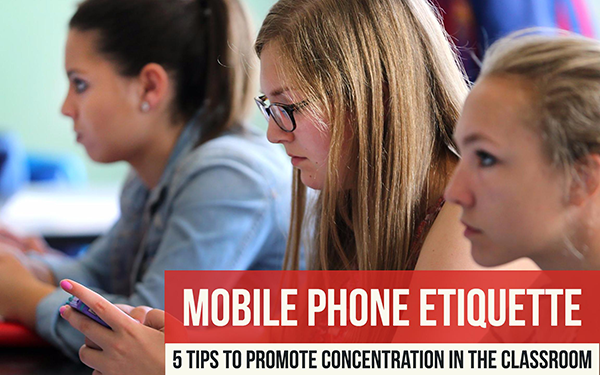10 Tips to Ensure Proper Use of Smartphones in the Classroom
 Lucie Renard —
Lucie Renard —
Mobile phones have been a teacher’s primary concern since they became highly rated mainstream gadgets a few decades ago. Back then, they were small devices with nothing much to offer, except calls, texts, and one or two simple popular games. But in nearly all schools, it was stringent policy to keep phones out of the classroom.
The reasons were valid. You couldn’t have your students playing Snake under the desk, or a disruptive ringtone rudely interrupting a class session. Then there was the issue of stigmatization among kids where phones would be regarded as a status symbol, alienating the learners who couldn’t have them for one reason or the other. Mobile phones weren’t all bad, but to many teachers agreed that they were better left at home.
Fast forward to today, and advanced sophisticated handheld computers have replaced the little gadgets of old. Our lives are now centered around smartphones, and it’s impossible to keep them away from our kids. Regardless of school rules, these devices still find their way to school in pockets, purses, backpacks and hoodies. Even worse is we now have so many cheap smartphones in the market that, confiscate a phone today, and the same kid will have another tomorrow.
Experts have been deliberating on the role of smartphones in education schools for a while, and now, the general consensus seems to be leaning towards letting students have their way. Instead of prohibiting their use, teachers are advised to figure out the means to incorporate smartphones in the classroom.
Not only is this approach easier than enforcing a “no phones allowed” rule, but it also encourages kids to learn and concentrate because they’re using their favorite toys. Below are a few ways you can ensure the proper use of smartphones among learners.
10 tips to ensure the proper use of smartphones in the classroom
1. Create your own mobile phone policy
 Banning phones in class is hardly practical these days because kids will always find ways to break the rules. As a teacher, you should, therefore come up with a policy that works for you and your students.
Banning phones in class is hardly practical these days because kids will always find ways to break the rules. As a teacher, you should, therefore come up with a policy that works for you and your students.
For instance, you can allow the use of smartphones if it corresponds to what you’re teaching. Influence when students take out their smartphones by sharing with them a link to a helpful educational website or video, or by asking them to check for answers to emerge questions online. Also, introduce phones as a research tool in discussions, and let your students appreciate that their little devices have all the answers they need.

Additionally, don’t forget to insist that all phones be put in silent mode at all times, and when one rings, revoke the owner’s mobile phone privileges or think of another clever form of disciplinary action.
With an effective policy, smartphones can be great learning tools in the classroom.
2. Make use of educational apps
 The smartphone isn’t all games and social media applications. There are countless tools you can employ to make online learning easier for students. You can find suitable apps in online stores, regardless of the subject you teach. Countries of the World, for example, is a free, popular social science quiz app that provides demographic information about countries around the world. Take a look at this post for fun video apps.
The smartphone isn’t all games and social media applications. There are countless tools you can employ to make online learning easier for students. You can find suitable apps in online stores, regardless of the subject you teach. Countries of the World, for example, is a free, popular social science quiz app that provides demographic information about countries around the world. Take a look at this post for fun video apps.
Apps are an easier, friendlier and more convenient way for students to learn, than traditional books. Before using an app, however, check whether it’s approved for classroom use in your district and if it’s not, consult with your school and district administrators.
3. Use smartphones to assess learning
 In addition to educative and informative apps, smartphones allow access to assessment tools, which you can use to quiz the class after a lesson. A great example is Polleverywhere, which allows you to create questions with several potential answers, and have your students text in the responses, in just a few minutes.
In addition to educative and informative apps, smartphones allow access to assessment tools, which you can use to quiz the class after a lesson. A great example is Polleverywhere, which allows you to create questions with several potential answers, and have your students text in the responses, in just a few minutes.
Even the most affordable smartphones available to unprivileged learners can easily run most educational quiz apps. Such apps are more efficient than random traditional tests because you can quickly identify the areas that students had a hard time to grasp and go over them again. Moreover, learners will tend to concentrate more in the classroom if they expect a test at the end of every session.
4. Encourage the use of organization apps
 With smartphone apps, you can have your learners plan better for their studies. Remind, for example, lets you send reminders to your students when they have a test coming up or homework due the next day. These apps encourage kids to systemize their assignments, which means you won’t have cases where one forgets to do homework or read for an exam. You might also want to take look at these 8 brainstorm apps for a collaborative classroom.
With smartphone apps, you can have your learners plan better for their studies. Remind, for example, lets you send reminders to your students when they have a test coming up or homework due the next day. These apps encourage kids to systemize their assignments, which means you won’t have cases where one forgets to do homework or read for an exam. You might also want to take look at these 8 brainstorm apps for a collaborative classroom.

A student that keeps on track with class progress, even when out of the classroom will not feel lost when you’re teaching, and will, therefore, concentrate more.
5. Use classroom management apps
 Consider using innovative classroom management apps or software that allow you to effortlessly monitor and effectively control smartphone usage during class. These tools can help you ensure that students stay on task and use their devices for educational purposes. Equity Maps is a free app that enables teachers to track individual participation during small or large group discussions. Perfect for monitoring smartphone usage!
Consider using innovative classroom management apps or software that allow you to effortlessly monitor and effectively control smartphone usage during class. These tools can help you ensure that students stay on task and use their devices for educational purposes. Equity Maps is a free app that enables teachers to track individual participation during small or large group discussions. Perfect for monitoring smartphone usage!
6. Pick specific times for smartphone use
 Instead of banning smartphones outright, consider picking specific times during class when smartphone use is permitted and relevant. For instance, smartphones can be used for research, note-taking, or educational apps during certain parts of the lesson. Agree clear moments when smartphone use is allowed. Maybe on a Friday afternoon? ;)
Instead of banning smartphones outright, consider picking specific times during class when smartphone use is permitted and relevant. For instance, smartphones can be used for research, note-taking, or educational apps during certain parts of the lesson. Agree clear moments when smartphone use is allowed. Maybe on a Friday afternoon? ;)
7. Monitor and provide feedback
 Monitor how students use their smartphones during class. Give feedback and reminders where necessary to ensure they stay on track with their teaching tasks. Encourage them to ask questions if they are unsure about appropriate smartphone use. They will definitely feel more confident.
Monitor how students use their smartphones during class. Give feedback and reminders where necessary to ensure they stay on track with their teaching tasks. Encourage them to ask questions if they are unsure about appropriate smartphone use. They will definitely feel more confident.
8. QR codes
 Create QR codes and let students scan them for quick access to educational learning materials, digital attachments, etc. This makes them use the smartphone in a useful way. Students will be more motivated to view and study the lesson material and digital attachments. You can even create an educational quiz (with Kahoot for example) that requires your students to scan the QR code to participate.
Create QR codes and let students scan them for quick access to educational learning materials, digital attachments, etc. This makes them use the smartphone in a useful way. Students will be more motivated to view and study the lesson material and digital attachments. You can even create an educational quiz (with Kahoot for example) that requires your students to scan the QR code to participate.
9. Surveys
 Take quick online surveys of what students think and want by asking them to respond via smartphone apps designed specifically for real-time feedback. Surveymonkey is a popular free app where you get the responses you need in a short few minutes.
Take quick online surveys of what students think and want by asking them to respond via smartphone apps designed specifically for real-time feedback. Surveymonkey is a popular free app where you get the responses you need in a short few minutes.
10. Let your students have some fun
 As a final tip, it’s a good idea to allow some occasional smartphone fun in class. You can get kids to share a funny meme, or watch and discuss a hilarious but educational YouTube video, as long as they’re all doing the same thing. Use smartphones as tools to foster general knowledge, by planning “Did you know?” exercises, and encouraging your students to look up fun facts about anything that’s relevant.
As a final tip, it’s a good idea to allow some occasional smartphone fun in class. You can get kids to share a funny meme, or watch and discuss a hilarious but educational YouTube video, as long as they’re all doing the same thing. Use smartphones as tools to foster general knowledge, by planning “Did you know?” exercises, and encouraging your students to look up fun facts about anything that’s relevant.
And when the time comes for individual classwork, you can allow your students, especially those in middle and high school, to study with their headphones on. Research has shown that studying while listening to instrumental music often improves concentration and increases the amount of productive work done.
Wrap up
Many educators and administrators are still fearful of smartphones in school, but the truth is, considering how integrated smartphones are in their culture it barely seems acceptable to prohibit students’ access to the devices that have become such a huge part of their connected young lives. Schools need to come up with rational policies for the use of cellphones in the classroom. Instead of viewing them as a digital distraction, teachers should start using smartphones as the powerful tools of learning that they are. Are you ready for this change?
Do you have any other tips? Share them in our Facebook Teacher Community or mention us on X.
And me? I’m Lucie from BookWidgets. I’m happy to connect with you personally on X or LinkedIn.


